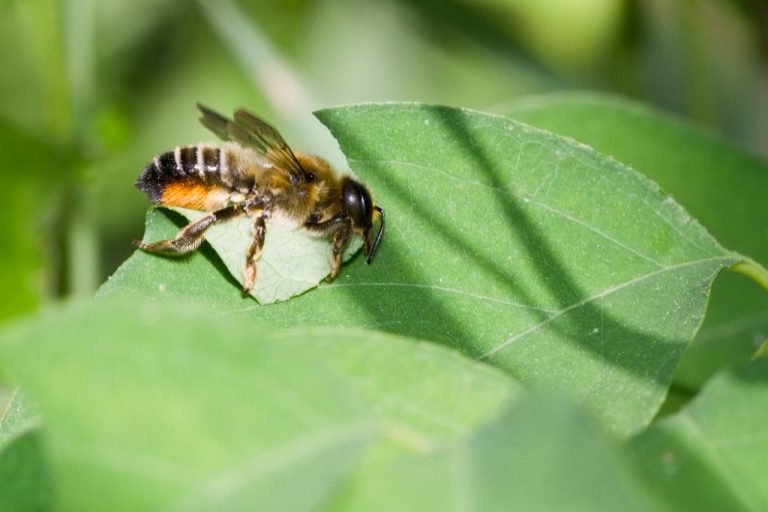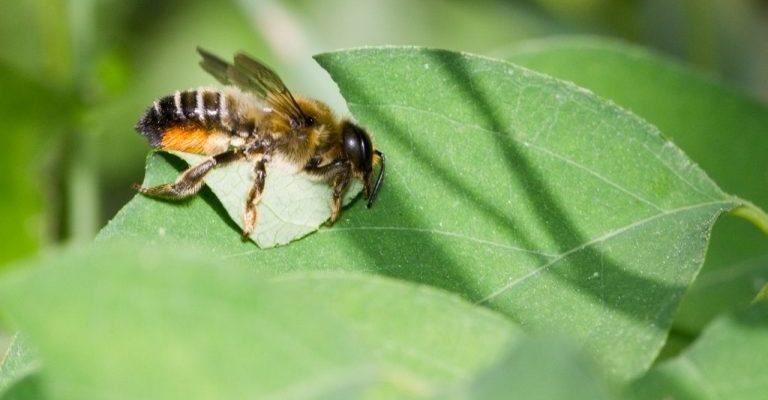
Let’s dive into some common misconceptions about leafcutter bees. Here’s the thing: knowing the truth about these buzzing little pollinators can help us appreciate their role in our ecosystems. So, grab a cup of coffee, and let’s get to the bottom of these myths.
Myth 1: Leafcutter Bees Are Dangerous
You might think that any bee is a threat, but that’s not quite true for leafcutter bees. Unlike honeybees or wasps, leafcutter bees are non-aggressive. They usually only sting if they feel threatened, which, let’s be honest, is pretty common behavior in many animals. They’re more interested in their leafy snacks than in bothering us.
These bees primarily use their time foraging for nectar and gathering plant material. Although they can sting, it’s actually quite rare. If you find a leafcutter bee in your garden, consider it a sign of a healthy ecosystem rather than a menace. Their presence means they’re hard at work pollinating your flowers, which is a huge benefit for your garden.
Why We Should Welcome Them
When we understand that leafcutter bees are friendly, we can welcome them into our gardens. Their unique ability to pollinate plants makes them essential for flowering plants, fruits, and vegetables. Think about the last time you enjoyed a delicious strawberry—leafcutter bees might have played a part in that!
By creating a bee-friendly environment, like planting native flowers and avoiding pesticides, you can attract these helpful insects. In turn, they provide pollination services for your garden, helping it flourish beautifully.
Myth 2: Leafcutter Bees Only Use One Type of Leaf
One of the biggest misconceptions about leafcutter bees is that they are picky eaters. You might think they only use one type of leaf—perhaps from a specific tree or shrub. In reality, leafcutter bees are quite versatile! They can cut leaves from a variety of plants, depending on what is available in their surroundings.
They’re especially fond of certain types of plants, such as roses and legumes, but they’ll adapt to whatever they can find. It’s like being at a buffet: they’ll take a bit of everything that suits their palate. This adaptability is what helps them thrive in various environments, from gardens to wildflower meadows.
The Evidence in Their Behavior
If you observe leafcutter bees, you’ll see them flying with tiny circles of green leaves—each cut piece is carefully chosen. This isn’t just random snipping; it’s a strategic selection for building nests. They typically prefer young, tender leaves, which are easier to cut and easier to mold into their nests. This behavior demonstrates how well they’ve adapted to their environment.
If you want to attract more leafcutter bees to your garden, consider planting a variety of flowering plants. This will not only provide them with different materials for their nests but also create a vibrant habitat for all sorts of pollinators.
Myth 3: Leafcutter Bees Are Solitary and Anti-social
While it’s true that leafcutter bees are mainly solitary, that doesn’t mean they’re complete loners. They can be social in their own right! Many people think that being solitary means they avoid others entirely, but this isn’t the whole story. Leafcutter bees often nest close to one another, sometimes in small colonies.
They might not live in the same hive like honeybees, but being near other leafcutter bees helps with pollination. When they’re in proximity, they can share information about good nectar sources, helping each other thrive.
How They Communicate
You might be wondering how these bees get along. While leafcutter bees don’t have complex communication like honeybees, they do use pheromones to convey messages about nesting sites and food sources. When one bee discovers a great spot for building a nest or finds a particularly rich nectar supply, it can signal to others nearby, making it easier for them to find food and resources.
Having leafcutter bees in your yard can encourage a supportive ecosystem, where each bee contributes to the overall health of the pollinator community.
Myth 4: Leafcutter Bees Are Harmful to Plants
Here’s a common worry: many people associate leafcutter bees’ leaf-cutting habits with plant damage. It’s understandable to think that snipping pieces off leaves might hurt plants, but that’s a misconception. The truth is, leafcutter bees typically don’t harm the overall health of the plants.
They strategically choose only the necessary parts of the leaves to create their nests. The leaves they cut serve as a building material, much like how we might use wood to build a home. While you might notice some leaves looking slightly tattered, most plants can withstand this minor damage without any long-term effects.
The Positive Impact of Leafcutter Bees
In fact, having leafcutter bees around can actually lead to healthier plants. As they move from flower to flower, they help pollinate, which encourages plants to produce more flowers and fruits. So, if you see a few leaves with bite marks, see it as a sign of a thriving ecosystem rather than a problem!
To keep your plants happy while enjoying the presence of these bees, you can provide alternative food sources, such as planting more flowers that attract them. This way, the bees can gather materials they need while helping your garden flourish.
Myth 5: Leafcutter Bees Can’t Survive in Cold Weather
Another myth is that leafcutter bees are weak and can’t survive cold climates. While it’s true that they’re more active in warm weather, they’re not as delicate as people think. Leafcutter bees have adapted to survive through various seasons, including the chillier months.
During winter, many species go into a state of dormancy, wrapping their eggs in a safe cocoon made from the same leaves they cut. This protective measure allows their young to emerge once the weather warms up. So, even though you might not see them buzzing around in the winter, they’re hibernating and waiting for the right time to wake up and get back to work.
Climate Adaptability
Some species of leafcutter bees are particularly hardy and can thrive in diverse habitats, from deserts to cooler regions. The ability to adapt to different climates indicates their resilience. This adaptability is essential for their survival as they can find ways to make it through seasonal changes.
If you live in a region with cold winters, rest assured that leafcutter bees will do their best to weather the cold until spring returns.
Understanding the truth behind these common myths about leafcutter bees can completely change our perception of them. They’re not dangerous, picky eaters, or antisocial; instead, they’re essential, friendly pollinators that contribute immensely to our ecosystems. By welcoming these little gardeners into our lives, we can help support the planet and enjoy the beauty of nature even more.
So, the next time you spot a leafcutter bee in your yard, remember: it’s just doing its part to help your plants thrive! Enjoy their presence, and consider planting flowers that attract these amazing little pollinators. You’ll not only enhance your garden but also be part of a larger movement to support our bee populations. Perfect, right?

